The Study In Brief
As families earn more taxable income, government benefit entitlements are reduced (or “clawed back”) at various phase-out rates, which reduces their overall cost for governments and ensures that they remain targeted to the intended lower-income families. However, benefit reductions act like hidden tax rates: They reduce the effective gain from working to generate additional income. To determine the tax system’s full impact on a family’s financial gain from work, one must take into account the combined effect of both taxes paid and cash benefit reductions.
This Commentary presents various estimates of effective tax rates on personal earnings for families with children. These effective rates play a key role in family work decisions by reducing the monetary reward of earned income. The “marginal” effective tax rate (METR) conveys the loss, through additional taxes and diminished benefits, associated with an extra dollar of earnings. For a working parent, it represents the financial penalty that must be paid from any small addition to their income. The “participation” tax rate (PTR) is the cumulative effect of all income taxes, other contributions, payroll deductions and loss of tax benefits on the entire prospective earnings from work.
METRs have generally been higher for lower-income families than those of higher-income families. In some cases, the lower-earning parent in a dual-earner family with three children might lose more than 80 cents of an extra dollar of earnings, and an unemployed parent lose more than 60 percent of a prospective salary if they take on a job. Nationally, 15 percent of working lone parents or the lower-earning parents in dual-income families face a METR above 50 percent, and 14 percent of stay-at-home parents face a PTR above 50 percent. And these proportions have risen substantially since the mid-1980s and early 1990s when very few families faced a METR or PTR greater than 50 percent.
To soften the bite of clawbacks on low-income families and encourage work Ottawa should:
- Implement its own benefit shields, similar to that introduced by Quebec in 2016, that would focus on the Child Tax Benefit and the Canada Workers Benefit. Under the shield approach, a sudden jump in employment earnings would be excluded for the purpose of calculating income-tested benefit reductions in the first year of recipients’ higher income earning capacity, such that family benefits for the CCB and the CWB would remain the same for that year. The shields would likely stimulate parents to take on more paid work. The immediate cost of such benefit shields would likely be small in comparison to the long-term repeated annual government revenue yield from higher family earnings.
- Allow income averaging to lessen the impact of fluctuating incomes on tax liability. Workers could average their income over many years, so that any single large earning year would not lead to a disproportionate loss of fiscal benefits and higher tax payments.
- Replace the federal childcare expense tax deduction with a refundable credit for childcare costs with very generous rates for lower-earning families – designed along the lines of the Quebec and Ontario childcare expenses credits – diminishing up the income scale to higher-earning families, who would still reap some benefit.
Clearly, geared-to-income fiscal benefit programs provide valuable financial assistance to families, but these benefits can result in low-income families facing very high METRs and PTRs. Federal and provincial policymakers should pay special attention to these effective tax rates when they consider changes to the tax and transfer system.
C.D. Howe Institute Commentary© is a periodic analysis of, and commentary on, current public policy issues. Barry Norris and James Fleming edited the manuscript; Yang Zhao prepared it for publication. As with all Institute publications, the views expressed here are those of the authors and do not necessarily reflect the opinions of the Institute’s members or Board of Directors. Quotation with appropriate credit is permissible.
Introduction
The income of Canadian families affects their taxes in two ways: the more they make, the more tax they owe, and the more they make, the less they receive in tax benefits.
Tax benefits are government payments to individuals. The largest are old age payments to seniors and benefits to families with children. Childrens’ benefits play an important role in the reduction of child poverty by providing income support to low-income families. For example, a low-income family of four with two young children in Ontario stood to receive over $20,000 in federal and provincial child and family benefits in 2022.
Governments must balance redistributive objectives with the effects of these tax benefits on the public purse. As families earn more taxable income, benefit entitlements are reduced (or “clawed back”) at various phase-out rates, which reduces their overall cost for governments and ensures that they remain targeted to the intended lower-income families. Benefit reductions, however, act like hidden tax rates: they reduce the effective gain from working to generate additional income. To determine the tax system’s full impact on a family’s financial gain from work, the combined effect of both taxes paid and cash benefits reduced must be taken into account.
This Commentary presents various estimates of effective tax rates on personal earnings for families with children.
“Effective” tax rates are computed by adding the amount of lost tax benefits to income taxes and payroll contributions paid, divided by gross earnings. In other words, effective tax rates comprise statutory income tax (federal and provincial), payroll and other tax contributions, plus the effect of tax-back or phase-out rates for each benefit program that the household is eligible to receive. Effective tax rates computed here do not take into account social assistance and other income-tested government assistance programs delivered outside the tax system. Adding these programs would worsen work disincentives at very low income levels. On the other hand, payroll contributions to social security programs – for example, Quebec’s parental insurance plan, employment insurance and the Canada Pension Plan – included in the tax computations might match expected eventual direct benefits, possibly reducing their effect on work incentives.
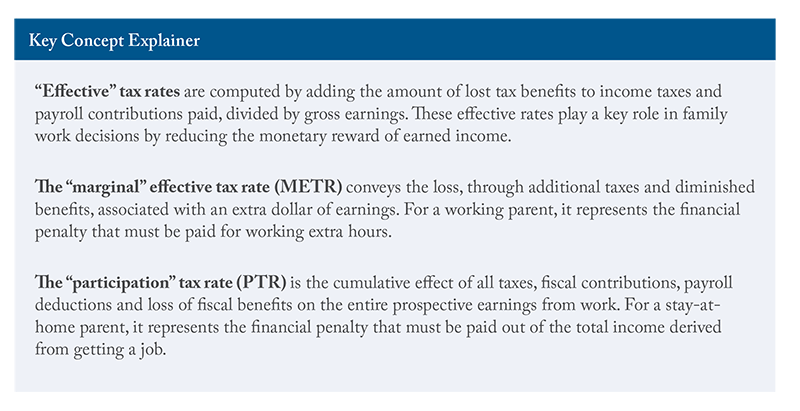
The “marginal” effective tax rate (METR) conveys the loss, through additional taxes and diminished benefits, associated with an extra dollar of earnings. For a working parent, it represents the financial penalty that must be paid for any small addition to income.
The “participation” tax rate (PTR) is the cumulative effect of all income taxes, other contributions, payroll deductions and loss of tax benefits on the person’s entire prospective earnings from work. For a stay-at-home parent, it represents the financial penalty that must be paid out of the total income derived from entering paid employment.
Box 1 tells the tale of two illustrative families to present the mechanics behind METR and PTR calculations.
Because benefit programs pile up at the lower end of the income scale, low-income families’ METRs generally have been higher than those of higher-income families. In some cases, the lower-earning parent in a dual-earner family with three children might lose more than 80 cents of an extra dollar of earnings, and an unemployed parent could lose more than 60 percent of a prospective salary from taking on a job. Nationally, 15 percent of working lone parents or the lower-earning parents in dual-income families face a METR above 50 percent, and 14 percent of stay-at-home parents face a PTR above 50 percent. Moreover, these proportions have risen substantially since the mid-1980s and early 1990s when very few families faced a METR or PTR greater than 50 percent.
Many studies have found a statistical relationship between family work hours and high marginal and participation rates – in particular, a negative impact on work incentives for mothers.
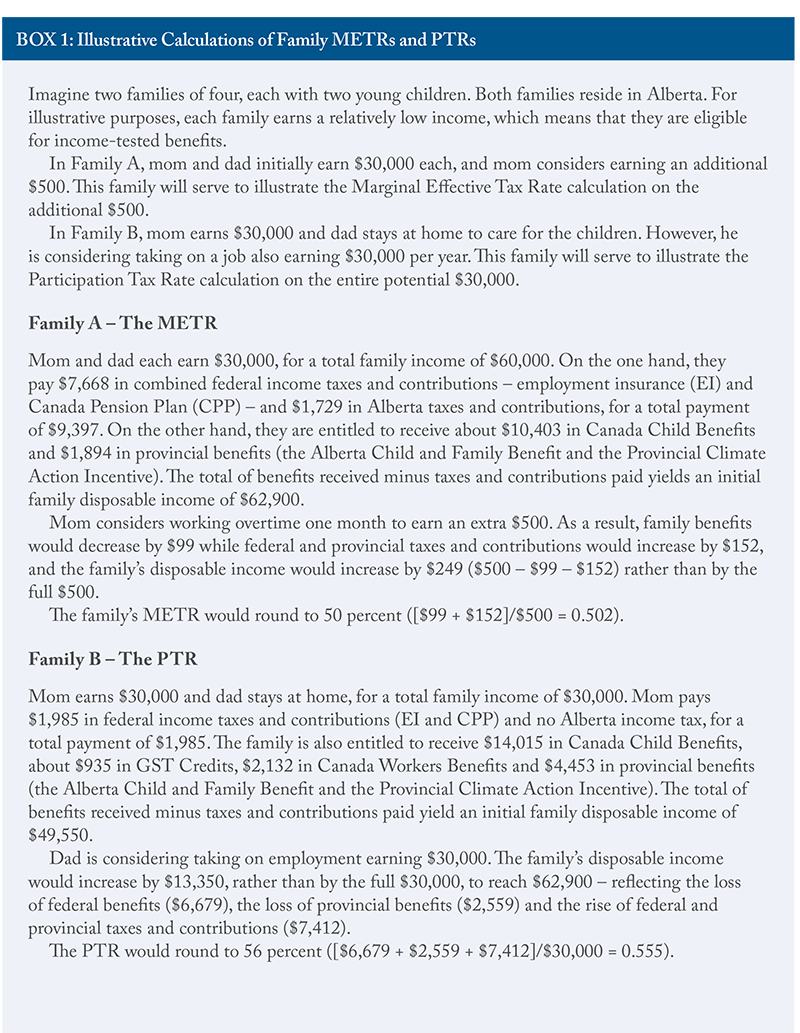
studies estimate that women and mothers, who are most often the secondary earner, and lower-skilled workers are much more responsive to wage and tax-rate variations. This means that high METRs or PTRs for a child-caring spouse are likely to affect the incentive to work longer hours, to seek part-time work or to re-enter the workforce. This leads
to fewer paid work hours than people might otherwise choose.
Because taxes and benefit programs can interact to create potentially extraordinarily high effective tax rates, governments need to be mindful of not discouraging work among these segments of the population, especially families with children eligible for generous child-related cash benefits.
Finally, other non-tax family costs also greatly influence the work decision. In particular, the subsidization of childcare expenses increases parental (primarily maternal) workforce participation. Indeed, many Organisation for Economic Co-operation and Development (OECD) countries’ tax and transfer systems already subsidize child care, and the OECD calculates a PTR estimate inclusive of childcare services as part of its work incentive indicators (OECD 2022). Our own estimate of PTRs inclusive of median child care expenses yield participation tax rates generally ranging from 50 percent to more than 80 percent in Canada.
METRs for Parents of Young Children
Consider a hypothetical two-parent family with young children. Both parents already work and earn income. However, one parent is considering whether to work more to earn extra income. One factor to consider in this decision is how much of the extra income the family can keep after deducting income taxes and the loss of tax benefits. In some income ranges and family situations, the family would lose more than half of each extra dollar of earnings – that is, the METR would be greater than 50 percent.
Five main factors determine the METR and how much the family would lose in taxes and benefits: the province of residence, the initial level of family income, the number of children, the number of earners in the family and how earnings are split among the earners. For illustrative simplicity, let us assume that, in dual-earner families, each spouse contributes half of the family income.
At very low family employment income levels – from about $3,000 to $12,000 – the Canada Workers Benefit (CWB, renamed in 2019 from the Working Income Tax Benefit) rewards workers for taking on more work, resulting in a negative METR.
METRs generally peak at family incomes around the $40,000 to $50,000 mark. In Ontario, the family METR on extra earned income peaks at 79 percent for two-children two-parent families
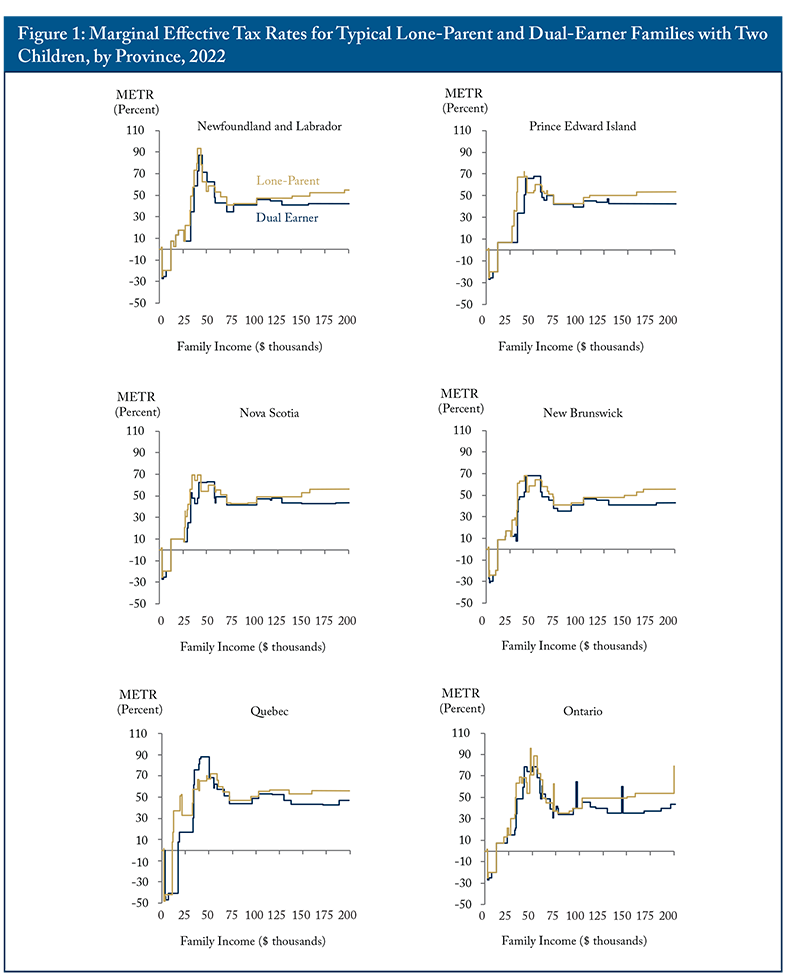
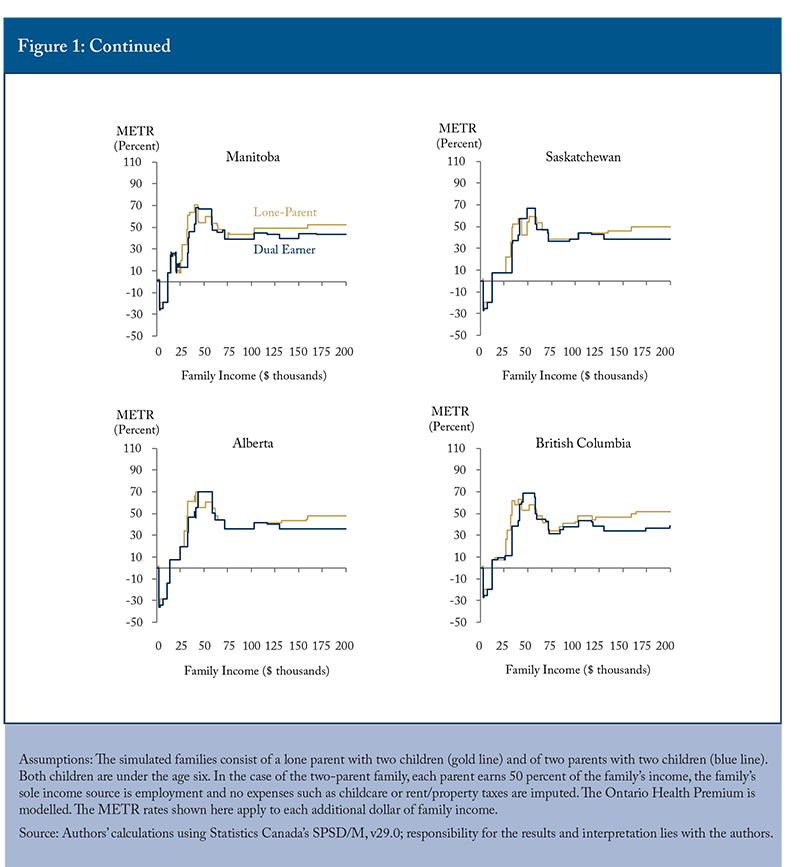
and at 96 percent for single-parent families. In Quebec, it peaks at 88 and 71 percent, respectively. In other provinces, it tends to peak at around 60 to 70 percent (Figure 1).
Participation Tax Rates for the Non-Working Second Parent in a Family
It is often difficult for workers to choose the number of hours they work in a job. Employment is usually offered on the basis of a set number of expected hours. In many two-parent families with young children, the second earner’s decision is whether to look for work or to remain at home as a caregiver. The greater the participation tax rate – the proportion of total earnings lost to taxes and withdrawn benefits – the lesser the incentive to take on employment.
Consider, for example, two hypothetical scenarios involving a parent of young children (often, but not necessarily, the mother), currently not employed but contemplating taking on paid work (Table 1). How much of this parent’s earnings would the family keep after taking into consideration additional taxes paid and benefits reduced? These sums, and the PTR, depend on the stay-at-home parent’s expected income and on the other parent’s income, since fiscal benefit entitlements are set according to family income, as are a few tax credits (such as the spousal credit) and other contributions (such as the Ontario Health Premium).
In the first scenario, the currently unemployed parent is considering taking a job making $20,000 a year, while the working parent is making $45,000. In the second scenario, the unemployed parent is considering a job earning $50,000 a year, while the working parent is making $120,000. These two scenarios are roughly representative of dual-earner families with young children at the first quartile and third quartile, respectively, of the employment income distribution.
In the first scenario, where one parent already earns $45,000, the other parent contemplating earning $20,000 would face the highest PTRs in Quebec (a staggering 66 percent if there are three children, 60 percent if two children and 53 percent if one child), followed by Ontario (59 percent, 54 percent and 40 percent, respectively) and Alberta (59 percent, 51 percent and 41 percent, respectively), mainly due to the phase-out of generous income-tested child-related fiscal benefit programs. On average across Canada, PTRs of families in the first scenario would reach 58 percent for families with three children, 52 percent with two children and 42 percent with a single child. Importantly, about half of the PTR value at lower family income thresholds is generally accounted for by the withdrawal of income-tested government benefits.
PTRs come down substantially the more the first parent earns, since family benefits are lower in the first place or even fully clawed back. In the second scenario, if one parent earns $120,000, the family would lose in fiscal benefits only 3 to 12 percent -on average- of the prospective $50,000 that the other parent contemplates earning. With taxes and other contributions ranging from 25 percent
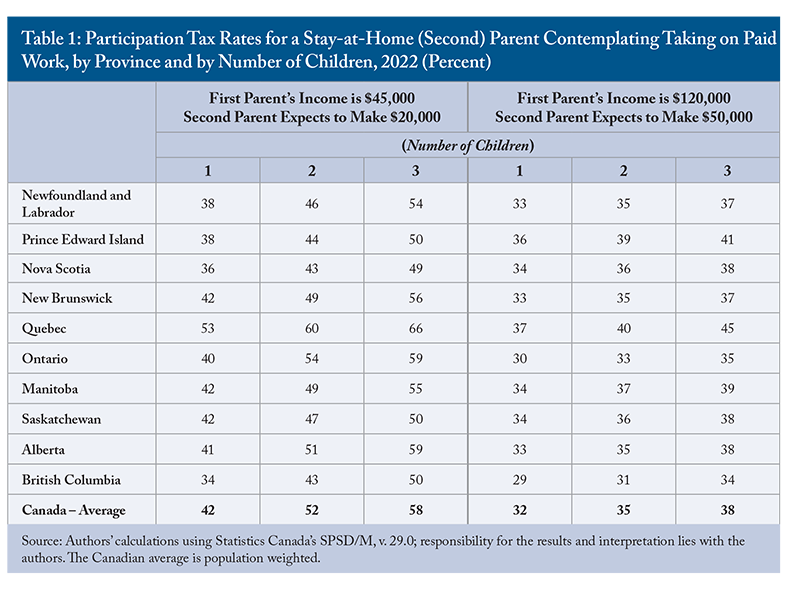 (British Columbia) to 33 percent (Quebec), PTRs would range from a low of 29–34 percent in British Columbia to a high of 37–45 percent in Quebec (Table 1). On average, at this higher family income level, PTRs would reach 38 percent for families with three children, 35 percent with two children and 32 percent with one child.
(British Columbia) to 33 percent (Quebec), PTRs would range from a low of 29–34 percent in British Columbia to a high of 37–45 percent in Quebec (Table 1). On average, at this higher family income level, PTRs would reach 38 percent for families with three children, 35 percent with two children and 32 percent with one child.
Taxes, contributions and benefit clawbacks are only one cost of employment for families. For the non-working parent, taking on employment can mean added expenses to the family budget for transportation, work clothing and meals, for example. It can also mean added childcare expenses. It is possible to compute PTRs inclusive of after-tax childcare expenses – that is, the cost of childcare expenses net of the impact of the childcare expense deductions (in addition to the childcare expense credit in Quebec and the newly implemented CARE
Figure 2 shows the impact of median after-tax childcare expenses claimed by families in Quebec, Ontario and the rest of Canada with two young children on PTRs for three potential income scenarios. Naturally, PTRs inclusive of net-of-tax childcare expenses are higher than in the base case, especially for lower-income families.
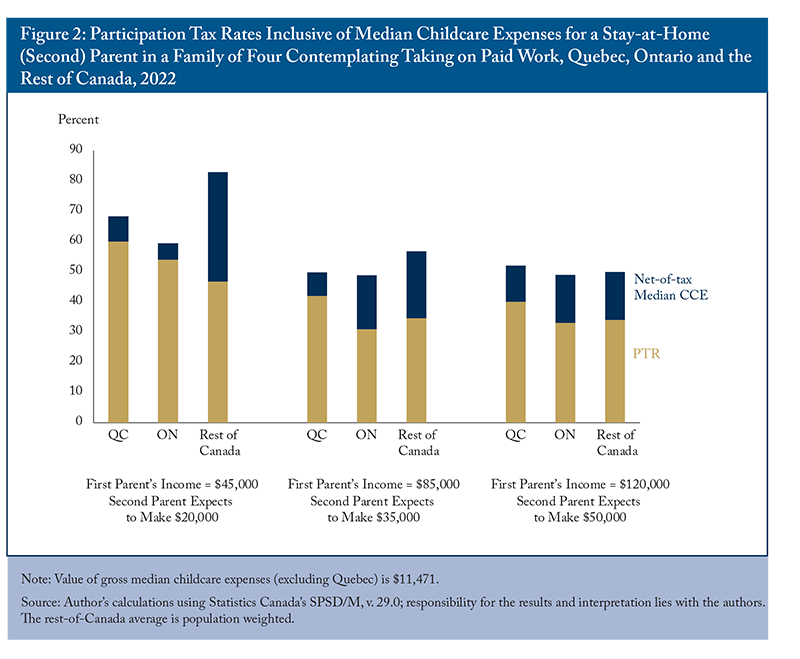
Outside Quebec and Ontario, in the scenario in which one parent already earns $45,000, the other parent contemplating earning $20,000 would face PTRs rising sharply from less than 50 percent to more than 80 percent on average as a result of net childcare costs. Such high PTRs are likely a significant hindrance to parents’ work participation. Quebec’s generous tax credit for childcare expenses and Ontario’s CARE produce lower after-tax childcare costs in those provinces than in the rest of Canada. At the lower income level, the new tax credit in Ontario in particular reduces PTRs from greater than 80 percent to less than 60 percent, the lowest of all provinces.
The federal government, in its 2021 budget, committed to a $30 billion program to reduce the cost of regulated childcare to $10 a day per child by 2026 and to increase the number of affordable spaces. Provinces are responsible for implementing their own plans in return for federal funding, and funding agreements have been signed by all provinces and territories. Quebec already has a subsidized childcare system in place in which the cost per child is capped at $8.70 per day in 2022 for parents not claiming the tax credit, so the new federal funds will be directed at creating new spaces.
The $10 per day subsidized cost of childcare naturally will reduce the PTRs of our illustrative families in Figure 2. Assuming families with two children in subsidized full-time care spend about $2,500 per child per year, outside Quebec and Ontario (where no childcare tax credits exist), PTRs inclusive of net-of-tax childcare expenses will diminish to a little more than 40 percent for families at higher-income levels. The biggest change will come in the lower-income scenario, dropping from 83 percent to 64 percent.
Since Ontario already has the CARE refundable tax credit in place and since the credit amount is geared to income, the biggest changes in PTRs will happen at higher-income levels in that province, where that rate will be a bit less than 40 percent. Interestingly, for the lower-income scenario in Ontario, PTRs will remain roughly the same because higher childcare costs attract additional tax breaks (the childcare expense tax deduction is large enough to produce an increase in the spousal credit amount) and additional benefit amounts (CARE amounts plus higher child and other benefits through lower net income).
Beyond reducing PTRs inclusive of childcare expenses, the net impact of the $10 per day childcare subsidy on labour participation is uncertain. Quebec’s subsidized system produced a large increase in childcare use and labour participation, resulting in about 74 percent of children younger than age six enrolled in a childcare program in 2019 (Ontario 2019, 11). But regulated childcare capacity in other provinces is far less than that in Quebec. In 2019, in the rest of the country, there were regulated childcare spaces for about 23 percent of children younger than age six. In 2026, that proportion could reach about 35 percent, considering provinces’ commitments to increase capacity under the funding agreements. Such low capacity, however, is not sufficient to increase the proportion of children in a regulated childcare arrangement, casting doubt on subsidized childcare’s ability to increase labour force participation beyond current levels. A strong labour force effect would require further large increases in the number of available regulated childcare spaces.
The Extent and Evolution of High METRs and PTRs for Canadian Families
The scenarios above show the extent to which Canadian families might be exposed to high marginal effective tax rates. But how typical are these scenarios?
There are currently about 2.3 million two-parent families with at least one child younger than age twelve. Of these, a third has a stay-at-home parent, and of the 1.6 million others, most lower-earning parents (84 percent) are mothers. In addition, there are about 0.4 million single-parent families with at least one child younger than age twelve.
Of all working lone parents and secondary-earning parents (the lower-earning parent in a two-parent family) in 2022, 25 percent face a METR below 30 percent. Another 63 percent face a METR between 31 and 50 percent, leaving 15 percent of lone/secondary-earning parents facing a METR higher than 50 percent (Figure 3). The share of parents facing very high METRs was starkly lower in the 1980s, before the introduction of income-tested refundable child tax credits in the 1990s. Between 1995 and 2022, the share of parents facing a METR higher than 50 percent remained relatively stable, oscillating between 10 and 17 percent.
The share of stay-at-home parents (in two-parent families) facing PTRs greater than 50 percent, on the other hand, has increased gradually since 1995 reflecting the expansion of the federal-provincial benefit system. From the mid-1980s to the mid-1990s, very few, if any, stay-at-home parents faced PTRs in excess of 50 percent. Since then, their share has increased to reach 17 percent of stay-at-home parents in 2019, falling slightly in 2022 to under 15 percent. Today, 28 percent face a PTR below 30 percent, another 57 percent face a PTR between 31 and 50 percent, leaving around 14 percent of non-working parents contemplating a high PTR of more than 50 percent (Figure 4).The share of parents facing high METRs is higher for lower-income families because they
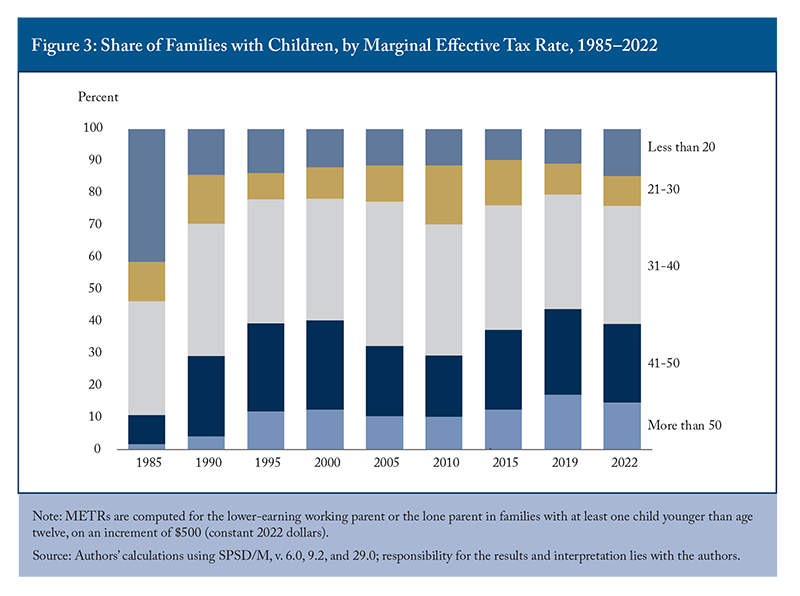 are the main recipients of income-tested benefits. Restricting the sample to family income lower than $75,000, the share of working lone parents and secondary earning parents facing a METR greater than 50 percent jumps to 34 percent. The share of stay-at-home parents facing a PTR greater than 50 percent jumps to 20 percent.
are the main recipients of income-tested benefits. Restricting the sample to family income lower than $75,000, the share of working lone parents and secondary earning parents facing a METR greater than 50 percent jumps to 34 percent. The share of stay-at-home parents facing a PTR greater than 50 percent jumps to 20 percent.
Simulating Potential Effects on the Decision to Work
Considering that costs other than taxes – such as childcare, transportation and clothing – might affect the financial decision to work, it seems reasonable to assume that high METRs and PTRs affect work decisions at the margin. Dudu et al. (2021) find that the 2016 reform of federal child benefits, which increased the program’s entitlements, led to “a significant decrease in hours worked by secondary earners in middle-income families.” So, what magnitude of work response could we expect from policies aimed at reducing effective rates? This is a very difficult question because estimated paid-work responsiveness to changes in taxes and benefits varies widely in the economic literature.
In general, lower-income, less educated people have a greater tendency to adjust their paid work behaviour through workforce participation decisions, while more educated workers tend to adjust through the number of hours they work. Older workers nearing retirement are also affected by the tax and transfer system (Duclos et al. 2014).
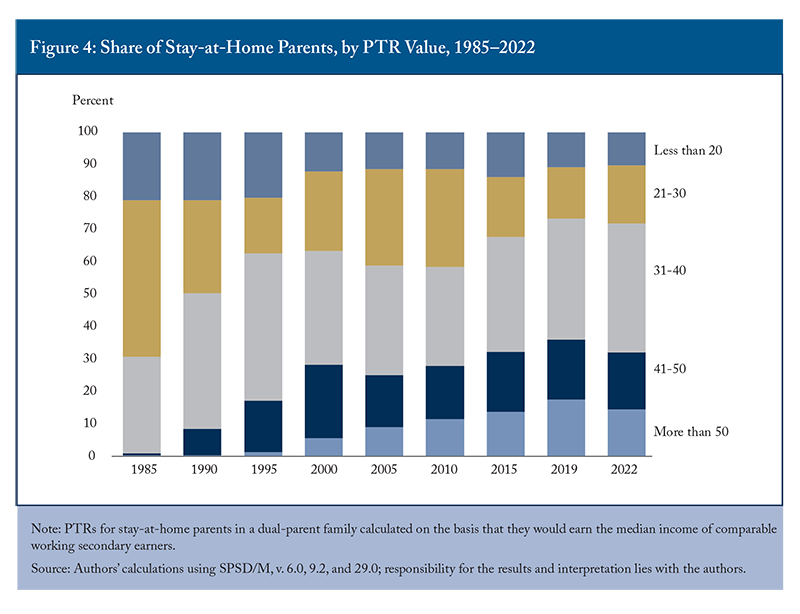
Although there is no real consensus in the literature, in general the evidence points to insignificant work responses of primary-earner men to tax changes and, if positive, the response level tends to be very low on average (Meghir and Phillips 2010).
On the other hand, the literature is more conclusive with respect to secondary earners in a family, especially mothers of young children and single mothers. This is especially true for the decision whether to take on paid work, which has been found to be quite sensitive to taxation and fiscal benefits for married women in particular. Causa (2009) and Kalyva et al. (2018) find that the effect of taxation on labour supply is in general stronger for low-skilled women and for those with young children.
Simulating the Efficiency Cost of the Federal Canada Child Benefit
The most targeted policy instrument to reduce effective tax rates for families with children would be to alter the reduction rates of the federal Canada Child Benefit (CCB), under which families may receive up to $6,997 per child under age six and $5,903 per child between the ages of six and seventeen. These amounts are reduced by 7 percent to 23 percent of income (depending on the number of children) between family income of $32,797 and $71,060, and by 3.2 percent to 9.5 percent on income beyond this threshold. CCB reduction rates are designed to target greater benefits to lower-income families, but this family income testing contributes to higher family METRs and PTRs, and thus comes with an economic efficiency cost.
It is practically impossible to reduce CCB clawback rates considerably across the board without producing large benefit redistributions from less to more well off families. Because society values redistributive fairness, especially if it leads to lower child poverty, the economic efficiency costs in this trade-off might still be lower than the value society attaches to income redistribution. This is the classic fiscal policy trade-off of income redistribution versus economic efficiency.
To evaluate the economic efficiency cost of CCB targeting, we can simulate an alternative scenario where practically all income-tested CCB reductions are eliminated while maintaining cost neutrality – that is, the annual fiscal cost of the CCB remains at its current level. In this no-clawback scenario, every family under a $400,000 income threshold would receive a flat, unreduced amount
To simulate the potential labour supply effects of higher METRs and PTRs, we can use response rate estimates found in the literature. Response rates are often evaluated from actual policy reforms in a quasi-experimental methodological framework, and thus a particular study might not always yield results applicable in a different context. For this reason, we use hours of work and workforce participation response rates for secondary earners that are conservatively in the low to mid-range of elasticities evaluated in the literature.
We calculate that higher PTRs might lead to a 9 percent increase in the number of stay-at-home parents, lowering aggregate employment income by about $2.4 billion and federal-provincial net revenues by $500 million. In addition, higher METRs might lead working secondary earning parents and lone parents to earn about $1,490 less, on average, translating into aggregate employment income lower by about $4.1 billion and federal-provincial net revenues lower by about $1.4 billion. In total, the fiscal efficiency cost of targeting the CCB to lower-income families would approach $1.9 billion, or 8 percent of the total fiscal cost of the CCB.
Policy Implications
Avoid Very High Rates by Better Integrating New Benefit Programs
The federal and provincial governments should be careful not to pile up income-tested fiscal benefit programs on top of one another, because clawback rates can add up to create very high effective tax rates – sometimes above 50 percent – at lower-income levels. Income testing of multiple fiscal benefits requires an integrated approach to reduction rates.
When thinking of new income-tested benefit programs, in particular, policymakers should be conscious of the added economic and fiscal costs associated with income testing and clawback rates – and this added efficiency cost should be balanced against the social benefits of income targeting. For example, in the case of the existing federal CCB, income testing provides higher benefits to low-income families but creates additional costs in terms of induced lower-paid work; we estimate that this effect on paid work decisions implicitly lowers aggregate net tax revenues by about 8 percent of the cost of CCB payments.
In 2016, the Quebec government, following through on a key recommendation from the 2015 Quebec Taxation Review Committee chaired by Luc Godbout, instituted a “benefit shield”
More than 274,000 Quebecers took advantage of the shield in 2018, for a cost of only $49 million. Originally, the credit ceiling was set at $2,500 per worker, but has since been increased to $4,000 in successive budgets (CRFFP 2019).
Ottawa could implement its own benefit shields, focusing on the Child Tax Benefit and the Canada Workers Benefit. Under the shield approach, a sudden jump in employment earnings would be excluded for the purpose of calculating income-tested benefit reductions in the first year of recipients’ higher income-earning capacity, such that family benefits for the CCB and the CWB would remain the same for that year.
The immediate cost of such benefit shields likely would be small compared with the long-term repeated annual government revenue yield of higher family earnings. We estimate the federal cost of shielding both the CCB and the CWB from existing potential benefit reductions (a minimum of $200) arising from jumps in employment earnings to be about $695 million per year. This cost would be small in relation to the cost of the programs.
In addition to this static cost, benefit shields could stimulate parents to take on more paid work. Assume that the work response rates are the same as those we used to calculate the efficiency cost of the CCB above (note 10). This simulated response would be at the upper range of possibilities for a benefit shield since family work decisions likely would respond less to a temporary benefit increase than to a permanent one. We estimate that CCB and CWB benefit shields could reduce the number of stay-at-home parents by eight percent, increase annual earnings by $3 billion and provide a sufficient annual increase in net federal and provincial revenues to compensate for the static cost of the shields.
The new economy is facilitating the development of labour arrangements in which workers become less attached to a single employer and move around more freely between projects and contracts. With these new structures comes increased potential for fluctuating incomes – a period of low earnings followed by a year of higher earning, or vice versa. Because extra income can be exposed to much higher effective tax rates, a worker with fluctuating income might end up paying more tax (and losing more income-tested government benefits) than another worker with a flat income profile but earning the same amount over a period of years.
Wen and Gordon (2017) find that Canada’s “fluctuation tax penalty” is most severe for individuals who earn lower incomes or are self-employed. One way to lessen the impact of fluctuating incomes on tax liability is to allow workers to average their income over many years, so that any single large earning year would not lead to a disproportionate loss of fiscal benefits and higher tax payments.
This kind of income averaging would play a function similar to a benefit shield, insulating workers against the loss of government income-tested benefits resulting from taking on extra work – and protecting them from being disproportionately affected by the steep increase in METRs at lower income levels. So, it would be best seen as a substitute to implementing benefit shields, as opposed to a complementary solution. It would apply across the board, limiting the need to overcomplicate the tax system by designing multiple benefit shields specific to each benefit program.
For most parents, childcare costs are like taxes in that they reduce the financial incentive to work. As shown in Figure 2, childcare costs can raise the PTR significantly for parents of young children, particularly in jurisdictions without extra fiscal subsidization. One interesting avenue for augmenting labour force participation among two-parent families would be to revisit the tax deduction granted for childcare expenses.
In the current system, childcare expenses must be deducted on the tax return of the lower-earning spouse, and claims cannot exceed the lower of either (a) two-thirds of the spouse’s income or (b) a maximum claim per child. As a result, up to one-third of families cannot fully deduct their childcare expenses because of the two-thirds-of-income limit (mostly among those at lower income levels) or the maximum claim limits (mostly among those at higher income levels) (Laurin and Milligan 2017).
In 1994, Quebec introduced a refundable credit for childcare costs, resulting in considerably lower PTRs for parents in lower-income families. Ontario did the same in 2019. Laurin and Milligan (2017) have proposed replacing the federal tax deduction with a refundable credit for childcare costs with very generous rates for lower-earning families – designed along the lines of the Quebec childcare expenses credit – diminishing up the income scale to higher-earning families, who would still reap some benefit.
With a credit – and depending, of course, on its level – low-income families could get most of their childcare expenses refunded. Because the work decisions of parents, especially mothers, are particularly sensitive to changes in childcare costs, a more generous tax recognition for such costs along the lines proposed here could encourage many more stay-at-home mothers to join the workforce and stay employed over the long term, alongside increasing government revenues (Laurin and Milligan 2017).
Conclusion
Federal and provincial policymakers should pay special attention to effective tax rates when they consider changes to the tax-and-transfer system. Clearly, geared-to-income fiscal benefit programs provide valuable financial assistance to families with children, but these benefits can come with high family METRs and PTRs, especially at lower-income levels.
Any further expansion of the targeted transfer system – through larger low-income supplements or the creation of new targeted family benefits, for example – should be approached with a broader analysis of the impact on parents’ work decisions. Relief measures meant to encourage work participation, such as creating one or multiple benefit shields inspired by the Quebec model, should be explored. Income-averaging provisions for highly fluctuating incomes could also be explored, as well as greater tax relief for childcare expenses – a key factor in family paid work decisions.
References
Bargain, Olivier, Kristian Orsini, and Andreas Peichl. 2013. “Comparing Labor Supply Elasticities in Europe and the US: New Results.” NEUJOBS Working Paper D 10.6. Vienna: Central European University. January.
Bartels, Charlotte, and Cortnie Shupe. 2018. “Drivers of Participation Elasticities across Europe: Gender or Earner Role within the Household?” Discussion Paper 11359. Bonn: IZA Institute of Labor Economics.
Bocconi University. 2011. “The Role and Impact of Labour Taxation Policies.” Milan: Centre for Research on the Public Sector.
Canada. 2022. Fall Economic Statement 2022. Department of Finance Canada. November.
Causa, Orsetta. 2009. “The Policy Determinants of Hours Worked across OECD Countries.” OECD Journal: Economic Studies 1: 1–40.
CRFFP (Chaire de recherche en fiscalité et en finances publiques). 2019. “Guide des mesures fiscales, année d’imposition 2018.” Cahier de recherche 2019/03. Sherbrooke, QC: Université de Sherbrooke.
Duclos, Jean-Yves, Arnaud Blancquaert, Nicholas-James Clavet, and Steeve Marchand. 2014. “La fiscalité québécoise et l’incitation au travail.” Working Paper. Quebec City: Commission d’examen sur la fiscalité.
Dudu, Alison, Zeus Eden, Theo Iordache, and Nathan McLean. 2021. “Is the Canada Child Benefit an Effective Policy? Impacts on Earnings and Incomes.” Finances of the Nation: Commentaries 2 (14).
Fortin, Bernard, and Guy Lacroix. 2002. “Assessing the Impact of Tax and Transfer Policies on Labour Supply: A Survey.” Montreal: Centre interuniversitaire de recherche en analyse des organisations. April.
Kalyva, Athena, Savina Princen, Alexander Leodolter, and Caterina Astarita. 2018. “Labour Taxation & Inclusive Growth.” European Economy Discussion Paper 084. Luxembourg: European Union.
Ontario. 2019. Financial Accountability Office of Ontario. Child Care in Ontario: A Review of Ontario’s New Child Care Tax Credit and Implications for Ontario’s Labour Force. Toronto: Queen’s Printer for Ontario. Fall.
Laurin, Alexandre. 2019. “The Paycheck Blues: Why Extra Work Is Often Not Worth the Effort for Lower-Income Families.” E-Brief. Toronto: C.D. Howe Institute. August 22.
Laurin, Alexandre, and Kevin Milligan. 2017. Tax Options for Childcare that Encourage Work, Flexibility, Choice, Fairness, and Quality. Commentary 481. Toronto: C.D. Howe Institute. May.
Meghir, Costas, and David Phillips. 2010. “Labour Supply and Taxes.” In Dimensions of Tax Design: The Mirrlees Review. London: Institute for Fiscal Studies.
Ohanian, Lee, Andrea Raffo, and Richard Rogerson. 2007. “Work and Taxes: Allocation of Time in OECD Countries.” Federal Reserve Bank of Kansas City Economic Review, Third Quarter.
OECD (Organisation for Economic Co-operation and Development). 2022. “The OECD Tax-Benefit Data Portal.” Available online at http://www.oecd.org/els/benefits-and-wages-statistics.htm
Tsounta, Evridiki. 2006. “Why Are Women Working So Much More in Canada? An International Perspective.” IMF Working Paper. Washington, DC: International Monetary Fund. April.
Wen, Jean-Francois, and Daniel V. Gordon. 2017. A Question of Fairness: Time to Reconsider Income-Averaging Provisions. Commentary 494. Toronto: C.D. Howe Institute. October.







